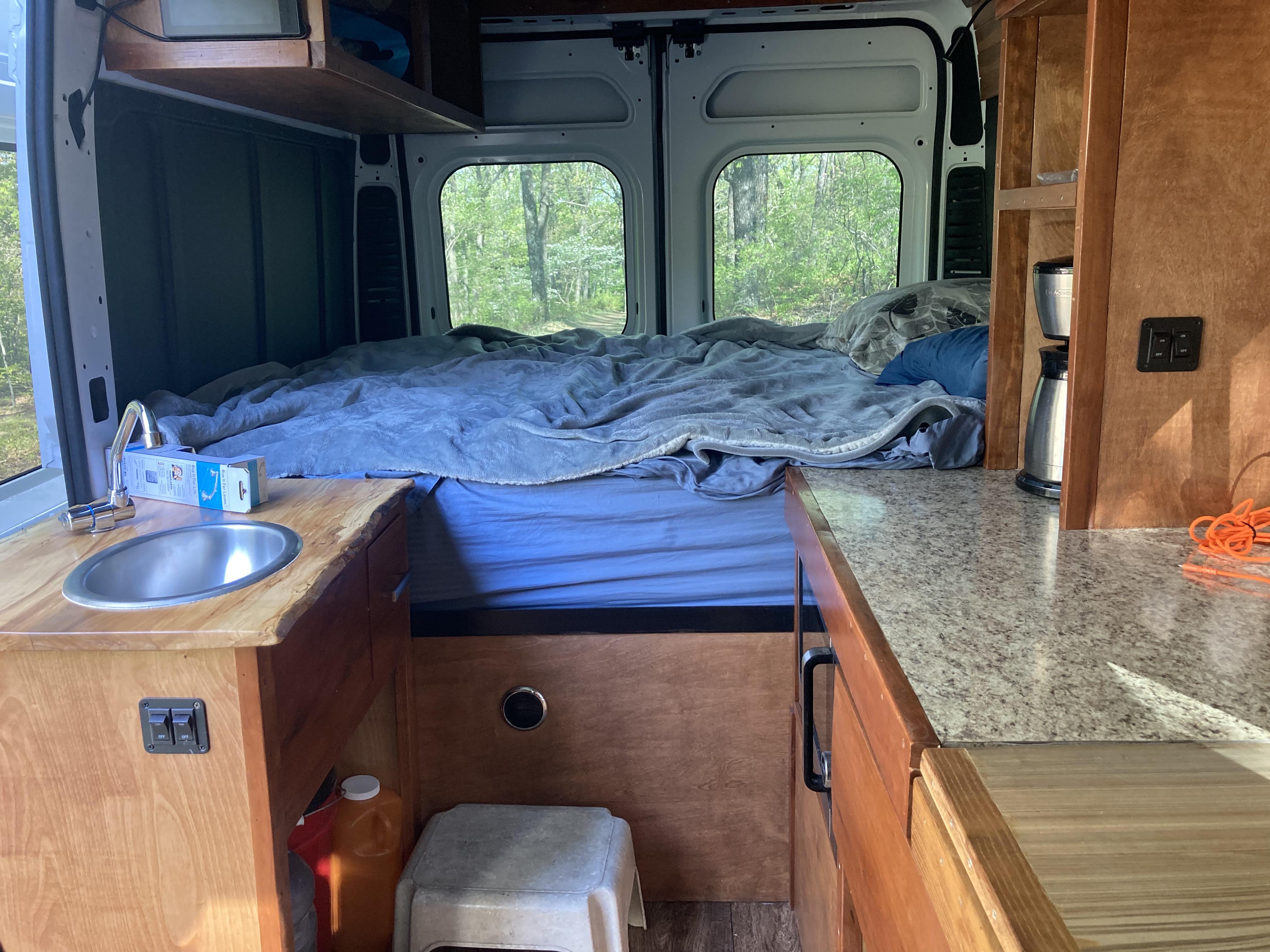Woody Hits the Road
Contact
University of Arkansas System Division of Agriculture
Cooperative Extension Service
2301 S. University Ave.
Little Rock, AR 72204

Woody Hits the Road
As I write this, I’m sitting in the woods in eastern Madison County waiting for my mini-split to take the morning chill off of the camper van I’ve spent the past eight months outfitting for the road. The Dodge Promaster van is a short wheelbase model with the footprint of a standard pickup truck, but as a camper, it is an improvement over my small van. I can stand up in this one to put my pants on in the morning.
I am generally loathe to name a vehicle, but Big Van was what I had been calling it when a friend suggested I call it Woody. Like naming a puppy, that fit perfectly. For I’ve taken special pains to include as many species of wood in the construction process as possible. At last count, I’m up to fifteen species in a cabin space that is just under 75 square feet.
Anyone with any design sense would scoff at the use of so many disparate woods in such a small space, but I don’t care. Woody is a celebration of wood and every species has a story to tell. As long as the memory of the various trees is kept alive in their stories, they are not dead. Merely transformed into another plane of existence.
I used both hardwood and softwood species in the construction process. As used in the temperate forestry trade, hardwoods are the deciduous trees of the forest while softwoods are the conifers (needle leafed evergreens). If the end grain of the wood is examined under a microscope it will be obvious that hardwood species have a series of vessels with secondary thickening while softwood species have smaller cells that lack the thicker cell walls. When tropical trees are included in the discussion, hardwoods are mostly broadleaf evergreen trees. Conifers are uncommon in tropical climates except at high elevations.
Hardness has been described for most tree species using the Janka hardness test. Originally developed to evaluate wood samples for use in hardwood flooring, the test measures the amount of force required to push a 7/16th-inch steel ball half-way into a piece of wood. We think of oak and maple as being hard, but these species are flimsy compared to some of the tropical hardwoods. For example, ebony requires 3,220 pounds of force to embed the ball bearing while white oak comes in at 1,360 pounds. Red oak is 1,290 pounds while Osage orange, the hardest wood I used, comes in at 2,010 pounds.
Loblolly and yellow pines have a hardness value of 690 pounds while bald cypress comes in at 510 pounds. But these values are averages and growing conditions influence how hard the wood actually is. Pines can grow too fast with really wide annual growth rings making them almost unfit for framing timber. I used recently-cut bald cypress for my ceiling because it was light weight, soft and easy to work into ship-lap siding. My dining table is old growth bald cypress that was cut before the Civil War and retrieved from the swamps of the Atchafalaya Basin in Louisiana about 25 years ago. Some of the sappy, tight grained logs sank on the way to the mills, lying submerged for 150 years where they began the slow process of absorbing minerals from the muck that surrounded them. Though of the same species, these two woods are very different.
The cabinets are trimmed in cherry recovered from the Fayetteville woods after the 2009 ice storm that caused so much damage from Oklahoma to Virginia. The Osage orange was used because its stiffness was need to flatten my 18-inch-wide tabletop of salvaged bald cypress wood. And Osage orange is perhaps my favorite tree, so I had to use it somewhere.
My utility drawer is lined with slippery elm in deference to my father. While cutting fence posts with dad one winter day when I was about 12, he explained to me that red elms were good for fence posts while white elms were pretty useless. As a lifelong student of trees, I’m ashamed to admit I never got what he was talking about until I was selecting wood for my van. His white elm was the tree I learned as American elm (it has soft, white wood) while his red elm I learned as slippery elm (Ulmus rubra, a tree with harder, red-tinged heartwood).
The black walnut came from the dulcimer shop in Mountain View; the live-edge maple counter top for the sink came from the Prairie Grove battlefield park; the white oak foot rests were skidded from the Ozarks hills by mules and cut into boards almost 50 years ago. Each of the many woods used to finish Woody has a story to tell, and as long as the stories are remembered, the trees live on.
